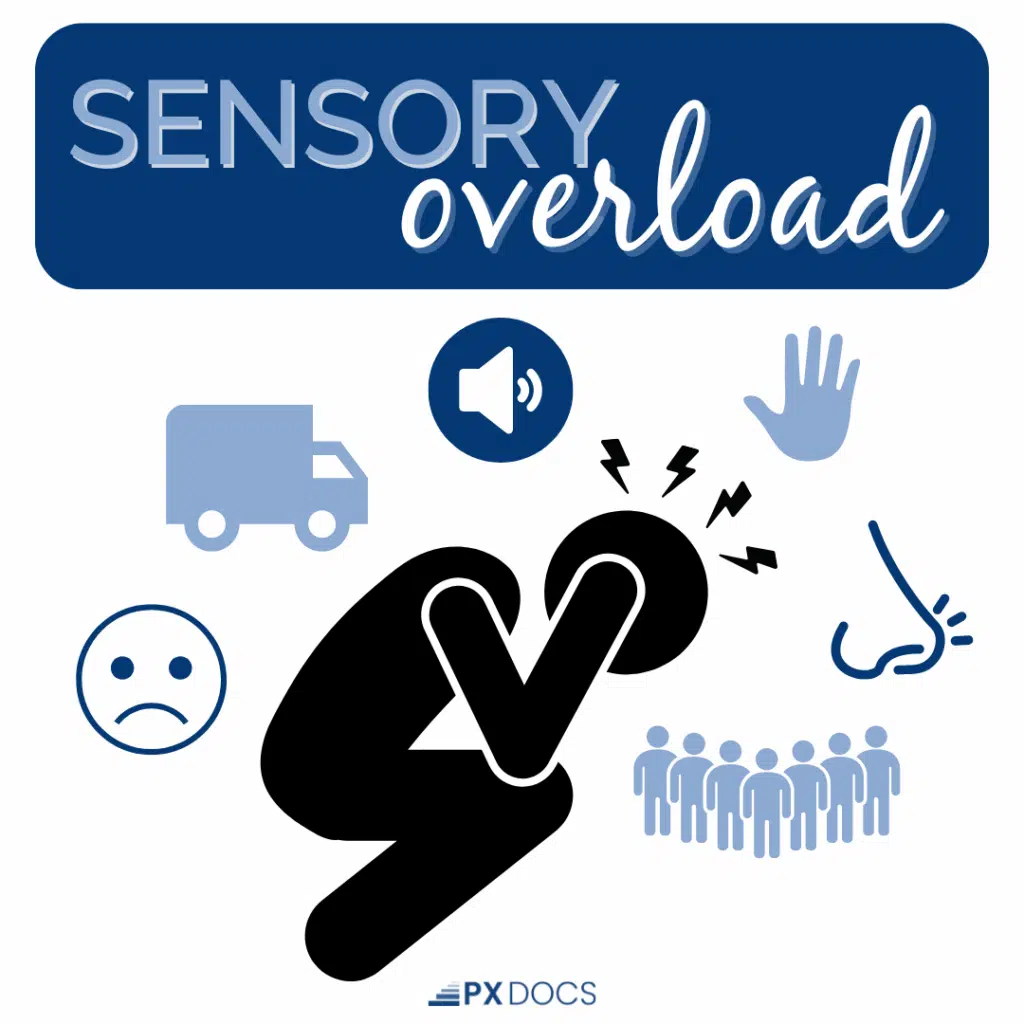Do you ever feel overwhelmed by the world around you? Bright lights, loud noises, or crowded spaces leave you feeling drained, anxious, or on edge. If this sounds familiar, you may be easily overstimulated, a state also known as sensory overload.
For highly sensitive people, overstimulation can be a daily challenge that interferes with work, relationships, and overall well-being. Research shows that 20% of people are highly sensitive to sensory input—meaning your brain receives and processes information more deeply than others. But what causes this heightened sensitivity, and why do some people seem to get overstimulated so easily?
If you’re wondering why you seem more affected by noise, lights, and chaos than those around you, you’re not alone, and you’re not imagining it. For highly sensitive people, this isn’t a weakness; it’s how your brain is wired.
In this article, we’ll explore the neurological roots of overstimulation, including how factors like prenatal stress, birth trauma, and early childhood experiences can contribute to sensory input processing issues. We’ll also discuss how Neurologically-Focused Chiropractic Care, a unique approach offered by PX Docs, can help restore balance to the sympathetic nervous system and relieve those struggling with sensory overload.
What is Overstimulation?
Overstimulation occurs when your brain receives more information than it can effectively process. This occurs when excessive sensory, emotional, or mental input is received simultaneously, overwhelming the nervous system’s ability to filter and respond appropriately.
While the terms are often used interchangeably, sensory overload specifically refers to overwhelming sensory input—sights, sounds, textures, and smells—while overstimulation can also include emotional and mental input. Both create that feeling of being trapped, cornered, or unable to think clearly. You might hear every sound deeply, feel like lights are too bright, or notice that your clothes feel unbearably uncomfortable, sensations others seem to unconsciously ignore.
When overstimulated, a person may experience a range of physical signs, including:
- Headaches or migraines
- Muscle tension or pain
- Fatigue or exhaustion
- Rapid heartbeat or chest tightness
- Nausea or digestive discomfort
In addition to these physical characteristics of overstimulation, it can also lead to cognitive and emotional challenges, such as:
- Difficulty concentrating or focusing
- Feeling overwhelmed or anxious
- Irritability or mood swings
- Withdrawal from social situations
- Sensory avoidance or seeking behaviors
It’s important to note that while overstimulation and Sensory Processing Disorder (SPD) share some similarities, they are not the same thing. SPD is a more complex neurological condition, affecting 5–16% of school-aged children, which influences how the brain processes and responds to sensory input. People with SPD may be over- or under-responsive to certain stimuli, and the traits of sensory overstimulation can interfere with daily functioning and development.
In contrast, overstimulation can happen to anyone, particularly those who are highly sensitive to their environment. It is a temporary state that occurs when the brain becomes overwhelmed, rather than a chronic condition like SPD. However, individuals with SPD may be more prone to experiencing overstimulation due to their unique sensory processing challenges.
Why You Get Overstimulated So Easily
As a parent, you’ve probably asked yourself this exact question while watching others handle chaos effortlessly. Why do the busy grocery store, the school cafeteria, or even family gatherings leave you feeling drained when others seem energized? The answer lies in how your brain processes information.
Highly Sensitive People: You’re Not Alone
Research by psychologist Dr. Elaine Aron indicates that approximately 15-20% of people are highly sensitive individuals (HSP), whose brains process sensory and emotional information more deeply than those of others. This isn’t a condition; it’s a genetic temperament trait affecting how your nervous system responds to stimulation.
Highly sensitive people have a lower threshold for sensory input. While most brains automatically filter out background noise through habituation, your brain may process every detail with equal intensity. You notice the flickering light that others ignore. You hear multiple conversations simultaneously—and your brain struggles to determine what deserves attention.

Individual Brain Differences and Filtering Capacity
Your brain’s filtering system works differently. In most people, the brain acts like a selective gatekeeper. But if you’re easily overstimulated, this filtering process is less efficient. Studies have found that individuals with sensory processing difficulties have altered pathways for brain connectivity.
Think of it like having more sensitive antennae picking up every signal. Your sensory cortex processes information more intensely, and your threshold for “too much” is lower. This means you reach overload faster—not because you’re weak, but because your brain is processing more data.
While some people are born with heightened sensitivity, others develop it through early nervous system stress. Birth trauma, prenatal stress, and difficult early childhood experiences can create nervous system dysregulation that amplifies sensory sensitivity. This is where the “Perfect Storm” becomes crucial—accumulated stress on your developing nervous system may have created acquired sensitivity.
The Nervous System’s Role in Sensory Processing
To understand why some people have an overactive nervous system, it’s important to explore its complex workings and its role in processing sensory information.
The brain and nervous system constantly receive input from the environment through our senses—sight, sound, touch, taste, and smell. This sensory information travels through complex networks of neurons, where it is filtered, interpreted, and integrated to create our perception of the world around us.
Your Brain on Overstimulation
When you’re overstimulated, critical communication breaks down in your brain. The cerebral cortex, your planning and reasoning center, normally partners with the amygdala (your fear center) to assess threats.
During overstimulation, your amygdala detects incoming stimuli—such as crowded rooms, overlapping conversations, and bright lights—and sounds the alarm. But the communication pathway shuts down. The amygdala keeps alarming, but the cerebral cortex can’t send the “all clear” signal.
This triggers your fight-or-flight response, releasing cortisol and adrenaline. Your body treats everyday overwhelm like a predator threat, activating survival mode in the grocery store.
Why Others Can “Tune It Out”
Most people experience habituation, where their brains automatically ignore repetitive, non-threatening stimuli. If you’re easily overstimulated, this filtering doesn’t work as efficiently. You notice and process every sound, light, and sensation others’ brains unconsciously dismiss.
The Autonomic Nervous System (ANS) plays a crucial role in regulating our body’s response to sensory input. The ANS is divided into two main branches:
- The Sympathetic Nervous System, which activates the “fight or flight” response in stressful or threatening situations
- The Parasympathetic Nervous System, which promotes “rest, regulate, and digest” functions and helps the body return to a state of calm
When the delicate balance between these two branches is disrupted, it can lead to a heightened stress response and difficulty processing sensory information. This is known as nervous system dysregulation and dysautonomia, and the most common presentation is an overactive sympathetic response.
One of the key players in this balance is the vagus nerve, a long, wandering nerve that connects the brain to various organs throughout the body. The vagus nerve is responsible for regulating many essential functions, including heart rate, digestion, and emotional responses. When the vagus nerve is functioning optimally, it helps to promote a sense of calm and resilience in the face of stress and sensory stimulation.
However, when the vagus nerve and other parts of the nervous system are not communicating effectively, it can lead to subluxation and dysautonomia. Subluxation refers to imbalances in the neurospinal system that can disrupt nervous system function and regulation. Subluxation interferes with your nervous system’s ability to filter and prioritize sensory information—similar to the filtering problems seen in ADHD, but with a neurological cause rooted in nervous system dysregulation rather than a neurotransmitter imbalance alone. Dysautonomia is an imbalance in the autonomic nervous system that can cause a wide range of characteristics, including sensory processing issues.
Birth trauma and early nervous system stress—key components of The “Perfect Storm”—can create patterns of nervous system dysregulation that show up years later as heightened stress reactivity and sensory sensitivity. In our clinical experience, we see that children who experienced difficult births often have lower thresholds for triggering the fight-or-flight response, suggesting their nervous systems remain in a more reactive state.
Adults and Parents Working Through Overstimulation
For parents already dealing with the stresses of everyday life, overstimulation can be particularly challenging. Many parents struggle with their children’s overstimulation while also trying to manage their own sensory needs. They often express feelings as though they’ve lost their patience, energy, and ability to cope with the daily challenges of family life.
The Overstimulated Parent
Parenting creates unique sensory demands that push even non-sensitive nervous systems into overload. Constant noise from children, frequent touching, hearing your name called repeatedly, managing clutter, never having alone time, and perpetual movement create relentless sensory input with no escape.
Overstimulated parents often feel unable to focus, snap at loved ones, or desperately need escape with no opportunity for solitude. Add remote work, household responsibilities, and sleep deprivation, and the sensory load becomes unbearable. This isn’t parenting failure—it’s nervous system overload.
If you experienced childhood stress or birth trauma, parenting demands can push you past your threshold faster.
Modern Life Amplifies Sensory Overload
Digital multitasking compounds the problem. Answering emails during Zoom calls, scrolling social media while cooking dinner, and managing constant notifications from texts, news alerts, and apps. This creates cognitive overload that amplifies your sensory sensitivity. Your brain is already processing environmental stimuli; adding digital noise pushes you into overstimulation even faster.
The cumulative effect of years of stress can lead to traits that are difficult to recover from, such as brain fog, poor sleep, and low energy—all potential signs of adrenal fatigue.
Similarly, teenagers face high demands related to their growth, hormones, academics, sports, extracurricular activities, and peer pressure. This constant stress cycle can quickly drain their energy, leaving them feeling exhausted and rundown.
At PX Docs, we categorize stress into three primary sources: physical, chemical, and emotional.
- Physical stressors include factors such as lack of sleep, excessive exercise, and injuries or illnesses that require extra energy and resources for healing.
- Chemical stressors often relate to diet and nutrition. Examples include poor eating habits, excessive sugar or caffeine intake, and exposure to environmental toxins or certain medications. These can place additional strain on the body’s nervous system.
- Emotional stressors are particularly evident in teens and adults. Factors such as relationship challenges, social pressures, academic or work demands, financial concerns, and the constant influx of digital information can all contribute to increased emotional stress.
Chronic stress can overload the HPA axis (Hypothalamus-Pituitary-Adrenal axis), the body’s primary stress-response system, which typically handles short bursts of stress by releasing cortisol and other hormones. When stress persists, the HPA axis remains continuously activated, resulting in elevated cortisol levels that can lead to dysregulation. This results in the nervous system being stuck in “fight-or-flight” mode, contributing to fatigue, anxiety, weakened immunity, and other traits.
“The Perfect Storm” of Factors That Contribute to Your Child’s Sensory Overload
While the nervous system plays a central role in sensory processing, it’s important to recognize that various factors throughout an individual’s life can impact its development and function. At PX Docs, we refer to this combination of influences as “The Perfect Storm.”
One key factor in this storm is prenatal stress and maternal health. During pregnancy, the developing fetus is highly attuned to the mother’s emotional state and physical well-being. Chronic stress, anxiety, or health issues during pregnancy can alter the development of the fetal brain, potentially setting the stage for sensory processing challenges later in life.
Birth interventions and trauma can also have a significant impact on a newborn’s delicate nervous system. Procedures such as forceps delivery, vacuum extraction, or cesarean section can cause physical stress and compression on the infant’s head and neck, potentially leading to subluxation and altered nerve function. Even seemingly routine interventions, like the use of epidurals or induction medications, can disrupt the natural birth process and affect the baby’s neurological development.
As children grow and develop, they may encounter various early childhood stressors and environmental factors that can further contribute to sensory processing issues. These may include:
- Exposure to toxins or pollutants
- Nutritional deficiencies or imbalances
- Physical or emotional trauma
- Chronic illness or infections
- Sensory deprivation or overstimulation
- Family stress or dysfunction
The cumulative effect of these factors over time can lead to a “Perfect Storm” of nervous system dysregulation, making it more difficult for the brain to effectively process and respond to sensory input. Just as a series of small cracks in a foundation can eventually compromise the stability of a building, the accumulation of these stressors can erode the resilience of the nervous system, leading to heightened sensitivity and overstimulation.
Conditions Commonly Associated with Sensory Overload
While anyone can experience sensory overload, certain neurological and mental health conditions can make individuals more susceptible to overstimulation. Some of the most common conditions associated with sensory processing challenges include:
- Anxiety conditions: Chronic anxiety can heighten sensitivity to environmental stimuli, exacerbating sensory processing issues and overstimulation.
- Post-Traumatic Stress Disorder (PTSD): Trauma can cause the nervous system to become hypervigilant and reactive, making it more challenging to regulate responses to sensory input.
- Sensory Processing Disorder (SPD): Sensory Processing Disorder is a neurological condition affecting how the brain processes sensory information. Some experience hypersensitivity (overwhelming response to stimuli, leading to avoidance), while others experience hyposensitivity or “sensory seeking” (needing more intense stimulation). Many individuals have a mix of both types.
- Autism Spectrum Disorder (ASD): Many individuals with ASD have difficulty processing sensory input and may be over- or under-responsive to certain stimuli. Individuals with Autism may experience alterations in the cortex—the brain region that processes sensory information—creating heightened sensitivity to light, sound, texture, and smell. In severe cases, overstimulation can lead to a meltdown (external emotional reaction) or shutdown (internal withdrawal and disconnection).
- Attention-Deficit/Hyperactivity Disorder (ADHD): People with ADHD often struggle with filtering out irrelevant sensory information, leading to feelings of overwhelm and overstimulation. In ADHD, lower dopamine levels can lead to overstimulation. Instead of unconsciously ignoring background noise or minor distractions, the ADHD brain processes every stimulus as equally important—the tapping pen, the ticking clock, the conversation across the room—leading to rapid overwhelm. This affects executive function, making it difficult to determine what deserves attention.
It’s important to recognize that while these conditions can increase the likelihood of experiencing sensory overload, not everyone with these diagnoses will struggle with overstimulation. Conversely, some individuals may be highly sensitive to sensory input without meeting the criteria for a specific neurological or mental health condition.
The PX Docs Approach: Neurologically-Focused Chiropractic Care
At PX Docs, we understand the profound impact that nervous system dysregulation can have on an individual’s ability to process sensory information effectively. That’s why we offer a unique approach to addressing overstimulation through Neurologically-Focused Chiropractic Care.
While therapy can teach coping skills for managing overstimulation, and occupational therapy can provide sensory strategies, Neurologically-Focused Chiropractic Care addresses the underlying nervous system dysregulation that may contribute to sensory sensitivity.
Research demonstrates that chiropractic adjustments can affect brain function—particularly the prefrontal cortex, which plays a key role in processing sensory information and regulating stress responses. While studies on sensory sensitivity are specifically limited, our clinical experience shows that addressing subluxation and supporting proper nervous system function can lead to reduced sensory reactivity and an improved ability to handle stimulation in many individuals.
Our approach begins with advanced diagnostic tools, such as INSiGHT Scans, which allow us to identify areas of subluxation and nervous system dysfunction that may be contributing to sensory processing challenges.
These objective neurological scans measure the exact stress patterns in your nervous system, showing us precisely where dysregulation exists and tracking improvements as care progresses. By pinpointing these imbalances, we can develop targeted care plans to support the brain-body connection and promote optimal nervous system function.
The images below represent a series of Neurological EMG scans on a patient struggling with sensory overload and overstimulation. The scan on the left shows a sympathetic dominant and overloaded system, the patient struggled with before starting care, with the red and black bars in the middle back representing a very common “stress zone” where adults, teens, and sometimes even children “hold” their stress and overstimulation in a major way. Then the scan on the right shows how the nervous system becomes much calmer and regulated.
How to Calm Down When Overstimulated
While seeking professional care is crucial for addressing the root causes of overstimulation, individuals and families can also implement various coping strategies to better manage sensory overload in their daily lives. Here are some tips to consider:
Immediate Relief Techniques
When you’re in the middle of an overstimulation episode, try these evidence-based grounding techniques:
- Box Breathing: Breathe in for 4 counts, hold for 4 counts, breathe out for 4 counts, hold for 4 counts. Repeat this cycle 4 times. This activates your parasympathetic nervous system, helping to calm the fight-or-flight response.
- 5-4-3-2-1 Grounding: Name 5 things you can see, 4 things you can hear, 3 things you can touch, 2 things you can smell, and 1 thing you can taste. This technique brings your prefrontal cortex back online, helping you process your environment more calmly.
Prevention and Environmental Management
- Create a sensory-friendly space: Designate a quiet, calm area in your home or workplace where you can retreat when feeling overwhelmed. Consider using soft lighting, comfortable textures, and soothing colors to promote relaxation.
- Develop a sensory toolkit: Keep noise-canceling headphones for loud environments, sunglasses for bright lights, fidget tools for restless energy, weighted blankets or vests for calming pressure, and a plan for quick exits when needed.
- Practice grounding techniques: Engage in activities that help you feel more connected to your body and the present moment, such as deep breathing, progressive muscle relaxation, or mindfulness meditation.
- Prioritize self-care: Make time for activities that nourish your nervous system, such as exercise, spending time in nature, engaging in creative pursuits, or connecting with loved ones.
- Communicate your needs: Don’t be afraid to advocate for yourself and your sensory needs. Let others know when you’re feeling overwhelmed and need a break or accommodations.
Remember, managing the signs of overstimulation in children and within yourself is a process, and what works for one person may not work for another. Be patient with yourself and don’t hesitate to reach out for support when you need it.
When to Seek Professional Help
While occasional overstimulation is normal, persistent sensory sensitivity that disrupts your daily life deserves professional evaluation. Consider seeking help from a mental health professional or occupational therapist if overstimulation is:
- Preventing you from participating in normal activities (work, school, social events, grocery shopping)
- Damaging your relationships because you snap at loved ones, withdraw frequently, or can’t engage in family activities
- Happening multiple times per week with increasing intensity
- Triggering panic attacks or causing you to feel unsafe in everyday situations
- Making you avoid places or situations you need to navigate for daily functioning
- Leaving you feeling exhausted, depressed, or hopeless about managing life
An occupational therapist can assess sensory processing challenges and provide targeted interventions to address them. A mental health professional can address anxiety, trauma, or ADHD components that may contribute to overstimulation.
At PX Docs, we take a different approach—evaluating the neurological root causes of sensory sensitivity through advanced INSiGHT scanning technology. While coping skills help you manage the symptoms, addressing underlying nervous system dysregulation through Neurologically-Focused Chiropractic Care may help reduce your baseline sensitivity over time, potentially allowing you to function more comfortably in environments that previously felt overwhelming.
A New Approach for Those Who Experience Sensory Overload
Navigating the world with a highly sensitive nervous system can be challenging, but here’s the truth: you are not alone, and more importantly, you are not stuck with this forever. Understanding the neurological roots of sensory overload and seeking the right support can transform your relationship with sensory input, building greater resilience.
Your sensitivity is not a weakness—it’s a unique aspect of your neurological wiring that deserves to be honored and supported. However, when that sensitivity prevents you from living fully, enjoying time with your family, or participating in activities others take for granted, it’s time to address the root cause.
If you or a loved one is struggling with overstimulation, we invite you to explore the resources and support available through our network of compassionate, skilled practitioners. Visit the PX Docs Directory to find a provider near you and take the first step on your journey to optimal nervous system health.
By embracing your sensitive nervous system and seeking the care that addresses why it became overreactive, you can reach your full potential and create a life of greater ease, joy, and connection. The “Perfect Storm” may have created your sensory sensitivity, but Neurologically-Focused Chiropractic Care can help calm the storm.ate a life of greater ease, joy, and connection.





